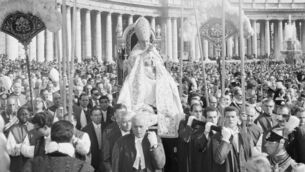Big decisions ahead for merged dioceses

The merger of the Diocese of Killala - with its cathedral church of St Muredach's in Ballina - and the Diocese of Tuam poses many interesting challenges for the Catholic Church in Ireland.
At present the two Catholic dioceses of Tuam and Killala are edging towards a merging of the (soon to be former) dioceses into a new union of both. This means that the old dioceses, as we have known them as Tuam and Killala, will cease to exist after an extended time span of 914 years – since the Synod of Rathbrasil first proposed boundaries for the dioceses of Ireland in the easily remembered year of 1111 a.d. The new ecclesiastical and legal entity as yet unnamed will be under the present Archbishop of Tuam, Francis Duffy.
Two years ago, the papal nuncio, Archbishop Luis Montemajor, visited Killala diocese to conduct a brief consultation with representatives of the priests and people of the diocese and a few weeks later when the chips fell, as we say, he returned to announce that the union of Tuam and Killala was in train.
The first stage was the appointment of Archbishop Duffy as Apostolic Administrator of Killala. The second stage is his imminent installation as Bishop of Killala. The third and final strange will take longer - months hopefully, rather than years - before the merging is completed. This last stage will take more time as it’s more complex, more time-consuming and more expensive than the first two in that it will involve technical adjustments like transferring property from the two former legal entities into a completely new legal entity. However, to all intents and purposes, the union will be up and running after Archbishop Duffy’s installation in St Muredach’s Cathedral, Ballina, in a few months’ time.
Meanwhile, the extended interlude between the decision to merge and the actual union provides a space for coming to terms with the change - its reality and its implications.
For one thing, it presents as a union of two uneven entities: Tuam has 56 parishes, 40 active priests and a Catholic population of 148,000. Killala has 22 parishes, 24 priests and a population of 34,524. This will present a series of interesting decisions.
Let me suggest some of them:
1. One is whether priests from one diocese will be appointed to serve in the other? Yes, would seem to be the answer to that but the odds are that such a change of scenery will be optional rather than compulsory, probably for some time.
2. Will there be an extended acceptance of two retreats, two cathedrals, two bishops’ houses, two (or four) vicar generals, two diocesan secretaries, two diocesan almost everything and anything in an effort to compensate for or just camouflage the perceived loss of past tradition and practice?
3. What strategy will be proposed as to what can be done to create an enhanced connection between clergy and religious in the new united diocese?
4. How can the Catholics of the two dioceses be helped to own and to settled into a united diocese whose extent will stretch to cover most of Mayo, much of Galway and a bit of Sligo and will extend from Beltra in Sligo to Clifden in Connemara?
5. How will the gap be closed between what is perceived by some as a just cause for grieving a personal loss over an extended period and by others as implementing the Roy Keane formula – ‘Just get on with it’?
6. How will the dilemma of expecting one bishop (even an archbishop) to be all things to all the people all the time be resolved - not least in running around 76 parishes for Confirmation?
7. Will the continued dispersal of honours continue in one dispensation - as with the appointment of ‘canons’ - while it is ‘perishing on the vine’ in another?
8. Will the new union be called ‘Tuam and Killala’ in deference to their long history or will it be called ‘Killala and Tuam’ as an alphabetical rather than a scale imperative might presume it to be - as with the recent union of ‘Achonry and Elphin’?
9. And last but not least. How will the present two different financial arrangements in Tuam and Killala be reconciled to ensure an even playing field?
As a result of the recent merging of Galway with Clonfert, Achonry with Elphin and Killala with Tuam, the west of Ireland has experienced a 50% reduction in the number of bishops – from six to three.
This doesn’t mean of course that the work-load on the three remaining bishops has multiplied by 100%! But what it does mean is that some necessary house-keeping arrangements need to be established on the basis of a pragmatic policy of ‘start as you expect to continue’. This means that a realistic and achievable organisation of, for example, the Confirmation circuit needs to be agreed, just as a cut-back in the number of Masses is well past its sell-by date. It also means that a certain deference in respect of age, health and travel is necessary if what emerges is to be achieveable.
The present change in the number of bishops as with the number of priests (and the number of Masses) allows an opportunity to assess current expectations on the basis of need and possibility rather than present expectation and practice. The evidence from a recent consultation among Catholics in Killala diocese is that the people have a much greater focus on their continued expectations of parish rather than on their diocesan identity. This is unsurprising as it is clear that difficulties at parish level very quickly gain the attention and purpose of the people while difficulties at diocesan level spark little or no interest.
Meanwhile, the recent decision of the Rome Synod to make mandatory Parish and Diocesan Councils - heretofore dependent on the decision of priests and bishops - now creates an opportunity for Catholics to have more of a say in their parish and diocese. An effective people-priest balance may be difficult enough to achieve in most dioceses. In the new diocese being created out of Killala and Tuam achieving that balance may be even more difficult.
We live in interesting times.





